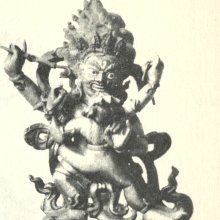Ushnishacakravarti, Uṣṇīṣacakravartī, Ushnisha-cakravarti, Ushnisha-cakravartin, Ushnishacakravartin, Uṣṇīṣacakravartin: 2 definitions
Introduction:
Ushnishacakravarti means something in Buddhism, Pali. If you want to know the exact meaning, history, etymology or English translation of this term then check out the descriptions on this page. Add your comment or reference to a book if you want to contribute to this summary article.
The Sanskrit terms Uṣṇīṣacakravartī and Uṣṇīṣacakravartin can be transliterated into English as Usnisacakravarti or Ushnishacakravarti or Usnisacakravartin or Ushnishacakravartin, using the IAST transliteration scheme (?).
Alternative spellings of this word include Ushnishachakravarti.
Images (photo gallery)
In Buddhism
Tibetan Buddhism (Vajrayana or tantric Buddhism)
Source: archive.org: The Indian Buddhist IconographyUṣṇīṣacakravartī (उष्णीषचक्रवर्ती) is another name for Uṣṇīṣa: one of the ten deities of the quarters (Dikpāla) presiding over the sky (above), commonly depicted in Buddhist Iconography , and mentioned in the 11th-century Niṣpannayogāvalī of Mahāpaṇḍita Abhayākara.—His Colour is yellow; he has three faces and six arms.—The ninth deity in this series is Uṣṇīṣa who is also known as Uṣṇīṣacakravartī, and presides over the sky above.

Tibetan Buddhism includes schools such as Nyingma, Kadampa, Kagyu and Gelug. Their primary canon of literature is divided in two broad categories: The Kangyur, which consists of Buddha’s words, and the Tengyur, which includes commentaries from various sources. Esotericism and tantra techniques (vajrayāna) are collected indepently.
General definition (in Buddhism)
Source: Wisdom Library: Dharma-samgrahaUṣṇīṣacakravartī (उष्णीषचक्रवर्ती) refers to the eighth of the “ten wrathful ones” (daśakrodha) as defined in the Dharma-saṃgraha (section 11). The Dharma-samgraha (Dharmasangraha) is an extensive glossary of Buddhist technical terms in Sanskrit (e.g., daśa-krodha and Uṣṇīṣacakravartī). The work is attributed to Nagarguna who lived around the 2nd century A.D.
See also (Relevant definitions)
Partial matches: Ushnisha, Cakravartin.
Full-text: Ushnisha, Dashakrodha, Ten Wrathful Ones.
Relevant text
Search found 1 books and stories containing Ushnishacakravarti, Uṣṇīṣacakravartī, Ushnisha-cakravarti, Ushnisha-cakravartin, Ushnishacakravartin, Uṣṇīṣacakravartin, Uṣṇīṣa-cakravartī, Uṣṇīṣa-cakravartin, Usnisa-cakravarti, Usnisa-cakravartin, Usnisacakravarti, Usnisacakravartin; (plurals include: Ushnishacakravartis, Uṣṇīṣacakravartīs, cakravartis, cakravartins, Ushnishacakravartins, Uṣṇīṣacakravartins, cakravartīs, Usnisacakravartis, Usnisacakravartins). You can also click to the full overview containing English textual excerpts. Below are direct links for the most relevant articles:
Guhyagarbha Tantra (with Commentary) (by Gyurme Dorje)
Text 7.2 (Commentary) < [Chapter 7 (text and commentary)]
Introduction 1.1: The Ritual associated with the site < [Chapter 9 (Text And Commentary)]

